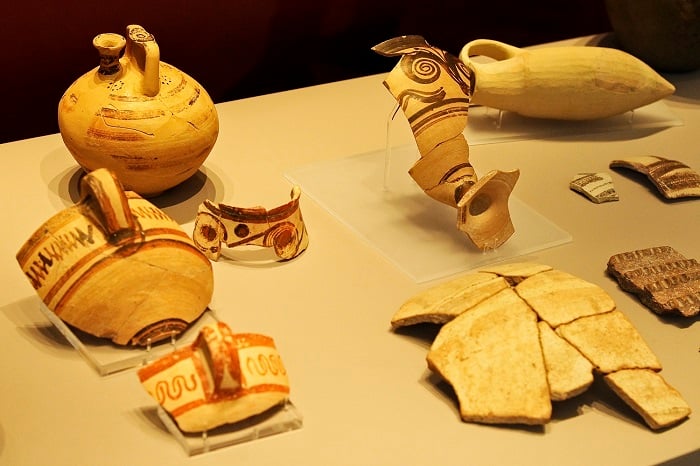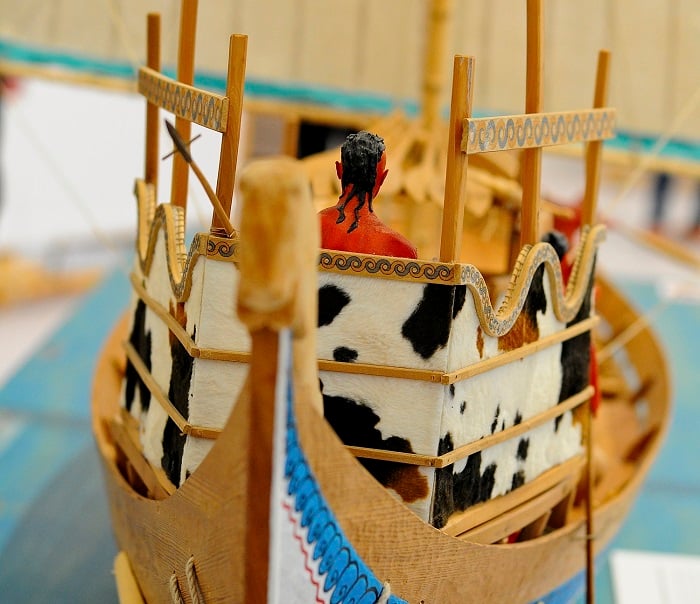By Phil Butler, Editor of Argophilia Travel News
Regional Governor Stavros Arnaoutakis unveiled the remarkable “Islands of the Winds” exhibition to mark the opening of the new Archaeological Museum of Mesara this past weekend in Crete’s Mesara Valley.
Local officials, members of the clergy, noted archaeologists, and about 200 history enthusiasts attended the January 25th event in the Gortys municipality. The opening featured a presentation of the exhibition and a seminar, ending with wine tasting and Minoan sweets paired with Cretan mountain tea.
Organized by the Ephorate of Antiquities of Heraklion and the Institute of Classical Archaeology of the University of Heidelberg in cooperation with the Region of Crete, “The Islands of the Winds: The Nautical Culture of the Prehistoric Aegean” exhibit brings to life the maritime traditions of the prehistoric Aegean.
Visitors to the museum complex will find a stunning display of 3D models of Minoan sailing vessels, seascapes and ancient ports, and detailed renditions of the shipbuilding facilities at the ports of Kommos and Zakros.
Detailed graphics, interactive displays, and numerous artifacts from the period are also on show in the exhibit.
Governor Stavros Arnaoutakis was joined at Saturday’s festivities by Heraklion MP Nikos Igoumenidis; Dr. Vassiliki Sithiakaki, the Director of the Heraklion Ephorate of Antiquities; Knossos Curator Dr. Kostis Christakis and many other archaeologists and experts in Minoan history.
The creator of the traveling exhibit, Dr. Diamantis Panagiotopoulos, the distinguished Director of the Institute of Classical Archaeology of the University of Heidelberg, led an informative tour for participants.
While meeting with the media after the event, Governor Arnaoutakis announced additional funding in the amount of €2.7 million for the completion, equipping, and digital applications of the permanent exhibition of the museum. Another €240,000 is slated for the completion of the excavation and restoration of the ancient theater of Gortyna nearby.
After the event, Dr. Panagiotopoulos spoke with interviewers about the vital importance of seafaring in ancient Minoan life. The archaeologist in charge of excavations at the Minoan Koumasa revealed a few more of their secrets at that time.
“One of the secrets of the impressive success story of the Minoan civilization in the first half of the 2nd millennium BCE was their long-distance seafaring capability. They literally turned the barrier of the open sea into a solid bridge of transcultural interaction,” Dr. Panagiotopoulos explained.
The professor went on to discuss the ways in which the Minoans dominated the Cyclades and the wider Aegean beginning as far back as the 3rd millennium BCE.
The Minoans, according to Panagiotopoulos, not only dominated the exchange of exotic goods, but their ships ferried what he termed “blind passengers,” meaning the “ideas and inspirations which fostered the dynamic development of Minoan society.”
The “Islands of the Winds” exhibition, Panagiotopoulos says, strives not only to present information and artifacts but also to explain maritime connectivity in the Aegean in a way that appeals to both learned archaeologists and the visitors who flock to Crete and are interested in history.
For most visitors, it appeared that the most impressive aspect of the new exhibit was the use of intricate models to convey the reality of Bronze Age navigation and seafaring. The beautiful models of Minoan vessels and the shipbuilding yards at Kommos and other centers were the presentations visitors most seemed to flock to on Saturday.
Through the use of these realistic displays, the exhibit realistically conveys how crucial the Minoans’ maritime prowess was to the development of the ancient world and the people of Crete.
Dr. Nikos Igoumenidis, the parliamentarian from Heraklion, noted at the event that he was very impressed with the exhibition while at the same time he remains focused on the completion of the larger museum project.
The MP went on to suggest that the Greek state should overcome the remaining bureaucratic processes swiftly so that museumgoers might soon be able to see the completed building complex.
The Minoan nautical exhibit runs from now until August 31st, 2020, when another traveling exhibition will take its place among the permanent exhibitions at the almost 3,000 square meter, €12 million euro facility.
See all the latest news from Greece and the world at Greekreporter.com. Contact our newsroom to report an update or send your story, photos and videos. Follow GR on Google News and subscribe here to our daily email!





